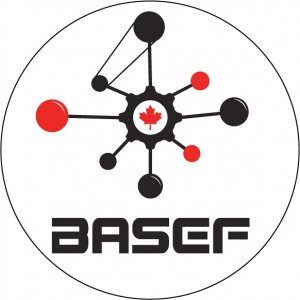
HWDSB Students Recognized at BASEF 2023
The Bay Area Science and Engineering Fair (BASEF) is a regional event that allows young people to explore their interests in the fields of science, technology, engineering, and math (STEM). It is an exciting opportunity for students to show off their work while gaining recognition for all their efforts. 
Annually, the fair attracts around 500 participants from grades seven to 12 across the Halton, Hamilton, Haldimand County, Norfolk County, Six Nations and County of Brant areas. BASEF is free to participate in and over $300,000 in cash, trips, and scholarships are awarded every year.
Isra Bashir, Westdale Secondary School student and second-place winner of BASEF’s Primary Fluid Systems Pinnacle Award, says the Fair is a great environment to create friendships with STEM students from other schools. Read the interview with Isra below to learn more about the BASEF experience.
Question: What made you want to participate in BASEF?
Answer: I first participated in the Bay Area Science and Engineering Fair with my friend in the seventh grade! We observed expired yogurt, and as much of a blast as that sounds, I slowly fell in love with researching and learning about the world around me. Believe it or not, it was a lot of fun, and the environment at BASEF is one that I’ll never forget. Sometimes you forget that it’s a competition, because you’re too busy being in awe of the hard work and passion that everyone put into their projects. The friendships and memories you make along the way are invaluable, and you know that you’re in the presence of people that are going to do something great.
Question: Can you describe what your project is about?
Answer: The purpose of my project this year was to integrate blood glucose and ketone detection, two staple medical diagnostic tests for diabetics, into one fluid system. I had a lot of fun designing and tinkering with the electrochemistry and biocatalytic reactions that go on inside a test strip, and proposed a model that would be cost-efficient and equitable. I plan on actually building the device this summer at McMaster!
Question: Why did you decide to do your project on this topic?
Answer: My younger sister is a type one diabetic, and when she was first diagnosed the amount of strips, needles and information that my family needed to learn was overwhelming at first. It seemed redundant to have two different sets of diagnostic tools for fairly similar testing processes, so I threw this idea around to simplify the issue. As I delved deeper into the equitable access of medical technology, I became more and more invested in pursuing the project. There are diabetics around the world just like my sister, who aren’t able to access the care they need due to financial obstacles, and I hope to begin having the important conversations on how we can break down those barriers by prioritizing global access in biotechnology.
Question: Any other comments?
Answer: If you’re debating trying science fair out, I strongly urge that you go and do it! There’s some preconceived notion that science fair projects are all incomprehensible and too complicated, deterring students from giving it a go at all. It can be intimidating, but the truth is, a project is about the love and care that you put into it. There’s no limit on what you choose to explore, all you need to do is have the courage to ask “Why?”
View HWDSB’s winners below and click the project names to view their submissions.
| Student Name | School | Project Name | Award(s) Won |
| Aadina, Syeda | Cathy Wever Elementary School | How Solar Cells Work |
|
| Basir, Isra | Westdale Secondary School | Sugar High! – Integrating glucose and ketone testing in a novel design to improve prevention of DKA |
|
| Chzhen, Maria | Westdale Secondary School | Comparison of regression algorithms in multivariable drought modeling and analysis |
|
| Dawson, Jamee | Highview Elementary School | How does temperature affect viscosity? |
|
| Diaz-Ruiz, Emilia | Westdale Secondary School | Oasis |
|
| Easo, Alex | Balaclava Elementary School | Light it Up – exploring renewable and non-renewable fuels |
|
| Eh Ku Ku Soe, Eh Ku Ku Soe | Cathy Wever Elementary School | How Solar Cells Work |
|
| Gouthro, Katelyn | Highview Elementary School | How does temperature affect viscosity? |
|
| Johnson, William | Guy B. Brown Elementary School | Gerbil Power |
|
| Jonkman, Clara | Westdale Secondary School | Chemical Properties of Kombucha |
|
| Jovicevic, Teodora | Ancaster Meadow Elementary School | Water’s PH |
|
| Kefel, Ali | Westdale Secondary School | An analysis of path planning algorithms for more efficient and optimal path planning |
|
| Kozyra, Gladys | Westdale Secondary School | Oasis |
|
| Mai, Ethan | Cathy Wever | Wireless Energy Transmission |
|
| Ndibmun, Hanniel | Cathy Wever Elementary School | Mobile Colours |
|
| Ngo, Hong | Westdale Secondary School | How does the pH of a saltwater solution affect the radicle length during the germination of Vigna radiata (mung beans)? |
|
| Nijjar, Redina | Cathy Wever Elementary School | Disco Bot |
|
| Noor, Farhan | Cathy Wever Elementary School | Wireless Energy Transmission |
|
| Truant, Alida | How to demonstrate Hand-fomite transmission of HPV |
|
|
| Xu, William | Dundas Valley Secondary School | A remote charging device with speed of light charging capabilities |
|
| Zhong, Kelly | Westmount Secondary School | Do genes impact the ability to learn a new skill? |
|
Updated on Wednesday, April 19, 2023.

